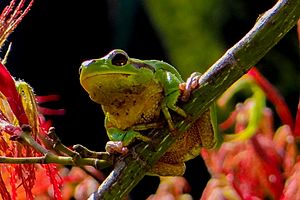Perrin's tree frog facts for kids
Quick facts for kids Perrin's tree frog |
|
|---|---|
 |
|
| Scientific classification | |
| Synonyms | |
|
Perrin's tree frog or Po's tree toad (Hyla perrini) is a small frog that lives in trees. It is found in parts of China, Italy, Switzerland, and Slovenia. These frogs are known for their bright green color and their ability to climb.
Scientists first found this frog on the flat lands near the Po River in Italy. For a long time, they thought it was the same as another frog called the Italian tree frog (Hyla intermedia). But in 2018, new research showed that Perrin's tree frog is actually a different, unique species.
Contents
What is Perrin's Tree Frog?
Perrin's tree frog is a type of tree frog. This means it spends most of its life in trees and bushes. It has special pads on its toes that help it stick to leaves and branches. These pads are like tiny suction cups.
Appearance and Size
These frogs are usually bright green, which helps them blend in with plants. They might have a dark stripe running along their sides. Perrin's tree frogs are quite small. They typically grow to be about 3 to 5 centimeters (1.2 to 2 inches) long.
Where Does It Live?
Perrin's tree frog lives in areas with lots of water and plants. You can find them near ponds, lakes, rivers, and wetlands. They prefer places with tall grasses, reeds, and trees where they can hide and hunt.
European Habitat
In Europe, these frogs are found in the Po River valley in northern Italy. They also live in parts of Switzerland and Slovenia. These areas have a warm climate and plenty of water sources.
Asian Habitat
The frog was originally described as being from China. This suggests a wider distribution, but its main known populations are in Europe. Scientists are still learning about its full range.
How Was It Discovered?
The story of Perrin's tree frog's discovery is interesting. For many years, scientists grouped it with the Italian tree frog. They looked very similar, so it was hard to tell them apart.
Genetic Clues
Modern science, especially DNA testing, helped solve the mystery. Scientists studied the DNA of different tree frogs. They found that the DNA of the frogs in the Po River valley was different enough to be a separate species. This is how Hyla perrini was officially named in 2018.
Different Calls
Besides DNA, scientists also noticed differences in their calls. Male frogs make calls to attract females. The calls of Perrin's tree frog are slightly different from those of the Italian tree frog. This was another clue that they were distinct species.
Life Cycle and Reproduction
Like most frogs, Perrin's tree frog goes through a metamorphosis. This means it changes from a tadpole into a frog.
Breeding Season
Perrin's tree frogs usually breed in the spring and early summer. This is when the weather is warm and there is plenty of water. Males will call from plants near the water to attract females.
Eggs and Tadpoles
Females lay their eggs in the water. The eggs hatch into tiny tadpoles. Tadpoles live in the water and breathe with gills. They eat algae and small bits of plants.
From Tadpole to Frog
Over several weeks, the tadpoles grow legs. Their tails get shorter, and they start to develop lungs to breathe air. Eventually, they leave the water as small froglets. These young frogs then climb into the plants and begin their adult lives.
What Does It Eat?
Perrin's tree frogs are carnivores. This means they eat other animals. They are skilled hunters.
Diet of Adults
Adult frogs mostly eat small insects. They use their long, sticky tongues to catch their prey. Their diet includes:
- Flies
- Mosquitoes
- Moths
- Small beetles
Hunting Habits
These frogs often hunt at night. They wait patiently on leaves or branches. When an insect comes close, they quickly snap it up. Their excellent camouflage helps them ambush their prey.
See also
 In Spanish: Hyla perrini para niños
In Spanish: Hyla perrini para niños

